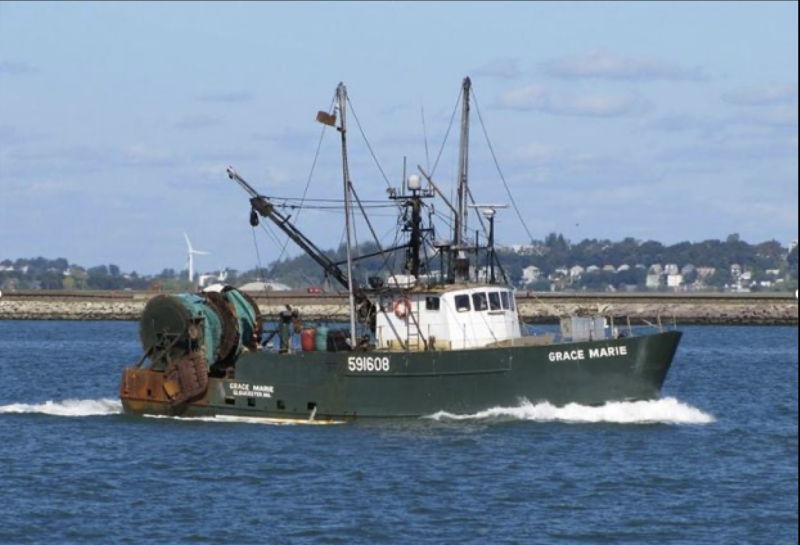The Gloucester, Mass., trawler Grace Marie likely sank when its doubler-plated hull failed under the engine room in July 2022, sending it to the bottom 80 miles offshore after its crew were rescued without injury, according to a new report from the National Transportation Safety Board.
“Although doubler plating can be used as a temporary repair solution, it is not generally suitable as a permanent repair for a vessel’s hull,” the NTSB report warns. “Vessel owners should crop out wasted steel on the hull and replace it by inserting new plating, instead of covering it up with doubler plating.”
The 65.3’x21’ Grace Marie had been fishing for two days, loading up 70,000 pounds of redfish, close to the fish hold’s 80,000-pound capacity. The captain and crew had turned to head for another area to fish on July 8, 2022, when the engine room began flooding around 10 p.m. The crew was unable to control flooding with the bilge pumps, finally abandoning ship to be rescued by another fishing vessel nearby.
While underway at 9:50 p.m., an engine room bilge high-level sensor alarmed in the wheelhouse. The crew later told investigators that engine room bilge high-level alarms were normal when the vessel was underway and fishing, as crew quarters sinks, deck drains and fish hold overflows drained to the bilge . (Many of the vessel’s accommodation sinks and deck drains fed into the engine room bilge. Crewmembers told investigators that they would typically receive an alarm once per day; the alarm would normally clear after several minutes of pumping.
When the captain received the bilge alarm in the wheelhouse, he started one of the vessel’s bilge pumps remotely. Ten minutes later at 10 p.m the engine room high-high bilge alarm sounded in the wheelhouse. The captain immediately went to the engine room to investigate with a deckhand. They saw water steadily rising in the engine room bilge, but neither could identify the source.
The captain manually started two additional bilge pumps to increase the rate of dewatering, and he also closed the vessel’s two seacocks to ensure that the water was not entering via a breach in the vessel’s saltwater cooling or priming systems. The water level continued to rise.
Once the water level in the bilge reached the propeller shaft, the captain instructed the deckhand to stop the main engine. Seeing the pumps were not keeping up with the rising water, the captain ordered the crew to prepare to abandon ship.
Donning immersion suits, the crew got ready and the Grace Marie’s life raft was launched, and tied it to the leeward side of the vessel. The captain ordered a mayday call on VHF Channel 16, which was picked up by the fishing vessel Dawn T. about 2.5 miles away. They contacted the Grace Marie and started making way to the stricken boat.
The Grace Marie crew cast off in the life raft, and were picked up within minutes by the Dawn T.
Built in 1978 by Rhode Island Marine Services in Snug Harbor, R.I., the Grace Marie was owned by AGV Company, purchased the vessel in 1997. The boat passed a Coast Guard dockside safety examination in August 2020, according to the NTSB report, which notes maintenance history for the boat’s hull.
“In 2018, a marine surveyor conducted a condition and valuation survey, which included a bottom survey of the vessel. The marine surveyor’s inspection report indicated that the vessel’s hull was constructed of a 1/4-inch welded steel plate with 3/8-inch steel doubler plates installed along each side of the keel,” the report says. “The vessel owner said that he had the doubler plates welded onto the vessel 8-10 years before the casualty because the material condition of the hull in that area was ‘a little spotty.’
“When describing the location of the installed doubler plating on the Grace Marie, the captain said that ‘under the engine room, it was all [doubler] plate.’ The marine surveyor indicated in the 2018 bottom survey report that the “hull was found to be in overall good condition for a vessel of its age with no damages, no blisters or electrolysis observed.”
While it is common for uninspected commercial fishing vessels such to use doubler plating to repair and reinforce damaged or wasted underwater hull sections, “doubler plate repairs can lead to increased stress concentrated in the area of the repair,” the report says. “Doubler plating also inhibits the ability to assess the true condition of the hull.”
NTSB investigators considered other potential sources of flooding, but discounted those based on their interviews with the captain and deckhands about their observations of the flooding.
The agency “determined the probable cause of the flooding and sinking of the Grace Marie was uncontrolled flooding of the engine room from an undetermined source, likely a failure of the doubler-plated hull below the engine room.”







